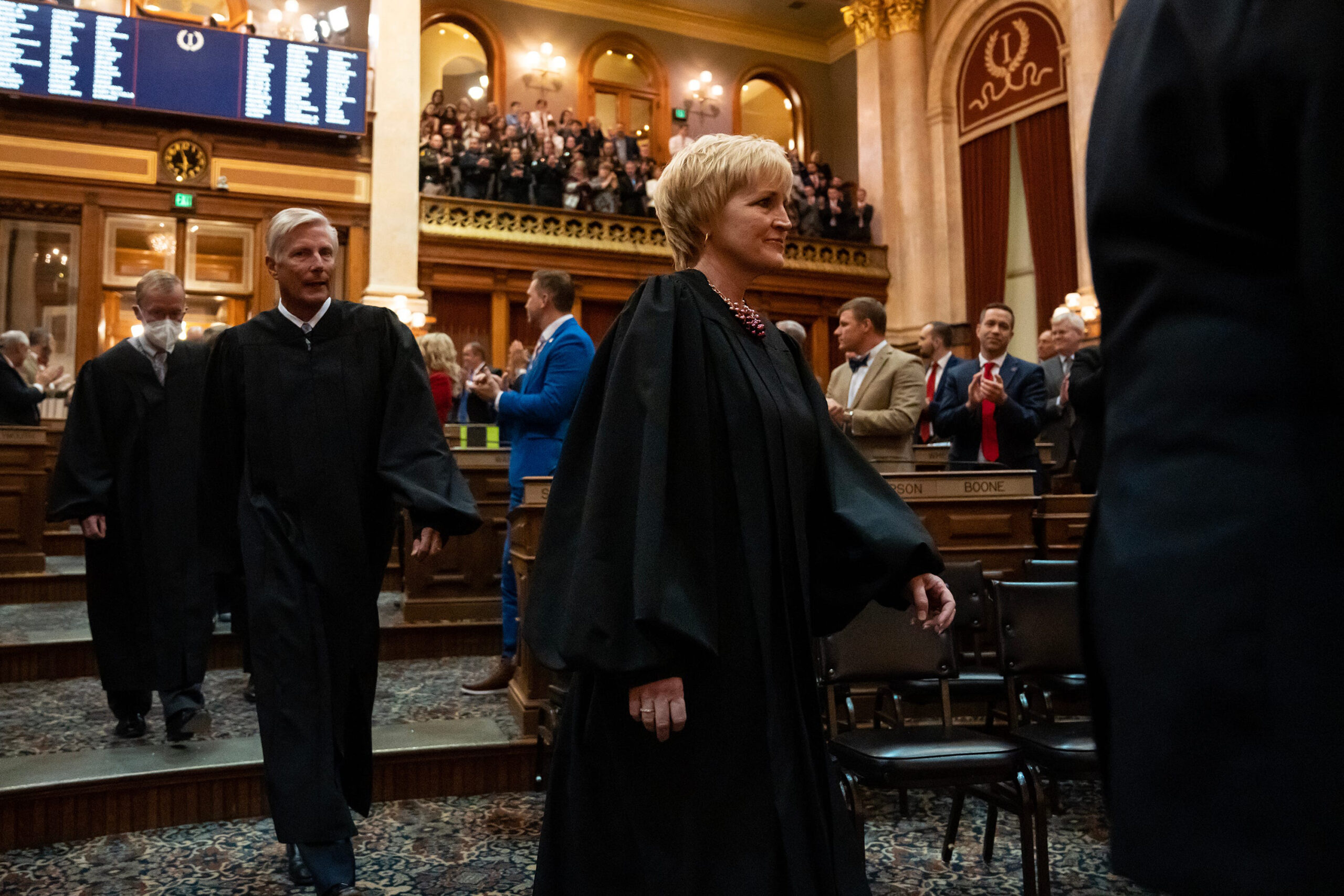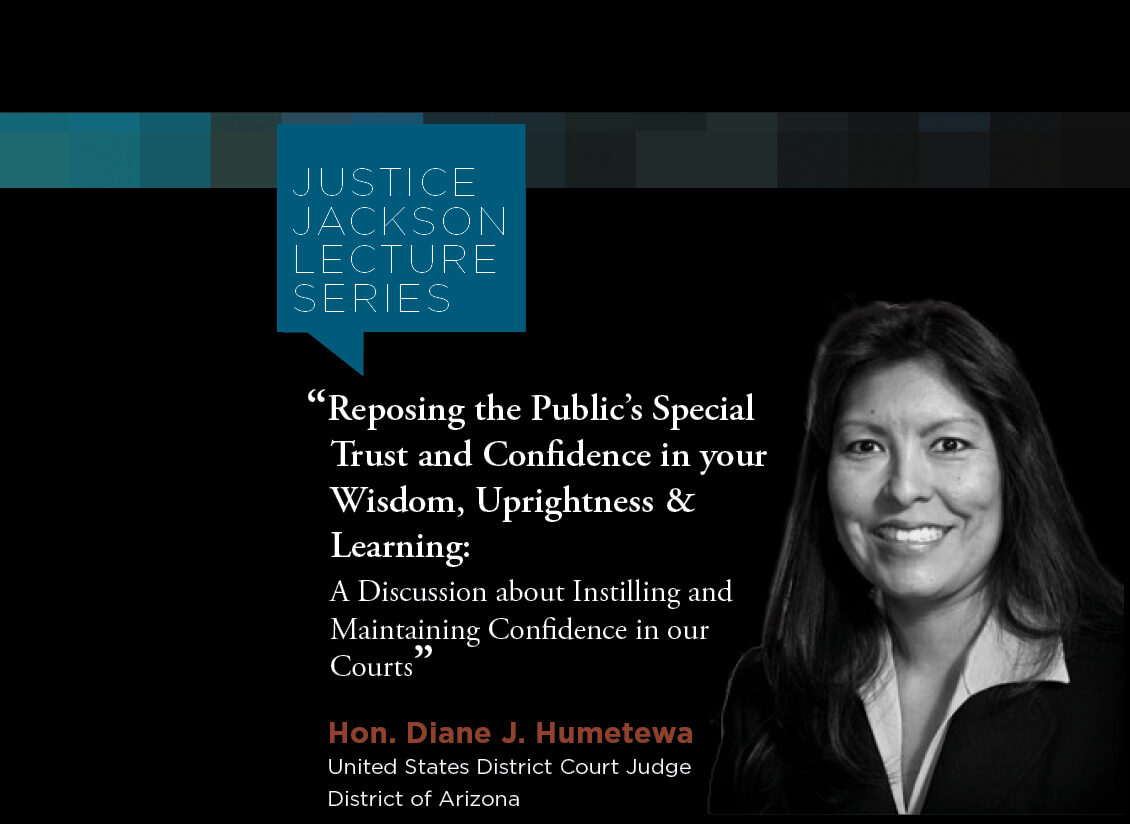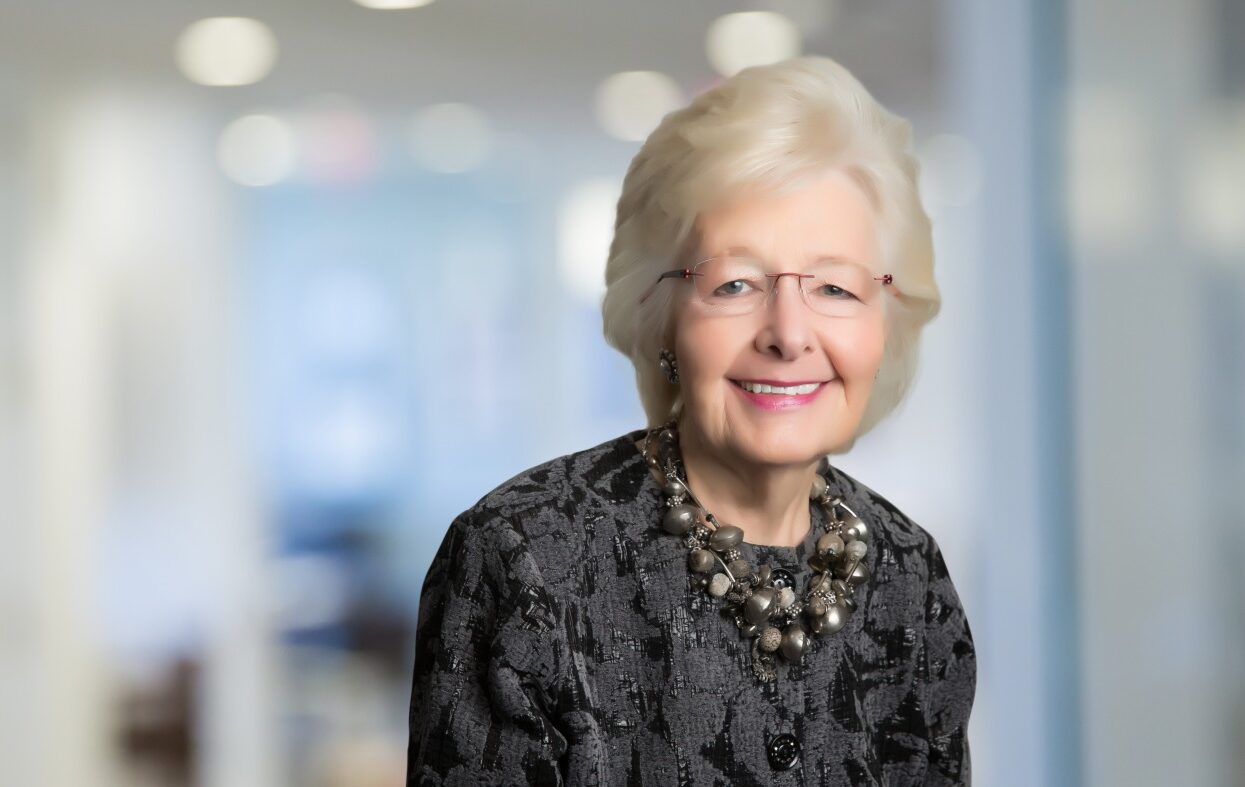
Iowa Supreme Court Chief Justice Susan (Larson) Christensen is following in some giant footsteps – her father’s – and even outdoing him in one respect. But her achievements of becoming the court’s third woman justice and second woman chief are bittersweet in one respect.
Her father, Jerry L. Larson – like her, an NJC alumnus – was the longest-serving justice in the history of the Iowa Supreme Court: 29 years, 8 months, 17 days. He would have easily eclipsed the 30-year mark, his daughter says, if not for Iowa having a mandatory retirement age for judges of 72.
“I think he would have stayed till the day he died,” she says.
Therein lies the bittersweet part. Suzy Larson Christensen took her seat on the Iowa Supreme Court on August 1, 2018, a little more than three months after her father died at age 81.
“He didn’t know that I was appointed to the Supreme Court or that I had even applied because when he died, there was no vacancy. I wish he could have known.”
Justice Jerry Larson did live long enough to see both Suzy and his son Jeff appointed to the state court bench (another son, David, is a lawyer and another daughter, Becky, is a teacher). Both Suzy and Jeff served in the same district in southwest Iowa that includes the family’s longtime hometown of Harlan, Iowa. It’s a hamlet of fewer than 5,000 people about an hour and 40 minutes west of the capital, Des Moines.
Their grandfather and uncle were both longtime lawyers in Harlan, and when Jeff and Suzy graduated from law school, they both joined the family practice. Their grandfather was still practicing law – after 50 years. He didn’t attend law school but followed the now virtually extinct practice of reading for the law.
Judge Jeff Larson, who is two years older than Chief Justice Christensen, was appointed a judge in the Fourth Judicial District, which includes Harlan, in 2003 and is now the chief judge. Chief Justice Christensen began her judicial career as an associate judge in the same district in 2007.
“I guess I’m his boss now, and I let him know that once in a while,” the chief justice says, a wink in her voice.
“She’s always been motivated, driven,” her brother says of his sister becoming chief justice. “I’m not surprised, I guess…. I’m happy to be working with her, and she’s got her work cut out for her, but I appreciate it.”
Despite being brought up in a family of lawyers, the chief justice says she never planned on going into the law herself. Her parents didn’t push her either.
“Mom and dad were always of the opinion that you should do what you’re passionate about.”
She had known her future husband, Dr. Jay Christensen, since they were children. They started dating in high school and decided to marry young, she says. They now have five children, including one with special needs, and eight grandchildren.
Jay Christensen is an optometrist with a practice on the ground floor of their two-story home on Harlan’s town square. The house is across the street from the county courthouse where Chief Justice Christensen and her father used to serve and where her brother still does. Judge Jeff Larson works in the same office their father once used.
Chief Justice Christensen says that after high school she enrolled in a one-year legal-secretary program, thinking she could earn some money while her husband went to college. Her plan was, “Then I’m gonna quit forever and just stay home, and we’ll have a family.”
It was while she was working in a law firm, she says, that she “got the bug.” One of the lawyers she worked for noticed how much she enjoyed job and said she should think about law school. After several moves for her husband’s education and jobs, she eventually graduated from Creighton University Law School in Omaha, less than an hour’s drive from Harlan. After graduation she practiced law in Harlan for 16 years.
All three of the Larson family judges took General Jurisdiction at the NJC after being appointed to the bench. When their dad attended in 1975, she says, she and Jeff were both teenagers and, understandably, not interested in traveling across the country to accompany their father to judge school.
Chief Justice Christensen says their mom took them to Arkansas instead to visit her grandmother, who lived in a community geared to older adults.
“Nobody living in that place was younger than my mom, so all four of us kids were bored to tears.”
One day, desperate for anything to do, she found some yellow construction paper and starting making an envelope to send to her father at judge school. She decorated it with Mickey Mouse and rainbows, stuffed it with gum, and mailed it to him in Reno.
She included a note that read, “Hah hah, I bet you wish you could chew this gum!”
This was an inside joke. Her father was a diabetic; she knew he couldn’t chew the sugary gum. But an odd thing happened: One day in class he had an insulin reaction and needed sugar. He remembered the fancy envelope with the gum he had stuffed in his briefcase. Crisis averted.
She says her father later told her, “You may have thought it was a joke, but it actually ended up being a little care package for me.”
Judge Jeff Larson says that when he came on the bench nearly 30 years later, his dad told him it would be worthwhile to attend the NJC. It turned out to be good advice.
“The Judicial College is a good experience for any young judge,” he says. “It gives you a lot of insight and help in figuring out how to be a judge, not so much the substantive law but how to conduct a trial and how to conduct yourself as a judge.”
His sister is equally enthusiastic about her NJC experience.
Like most NJC alumni, she says she came away with not just skills she could apply in the courtroom but friends and mentors for life among the course participants. She’s especially close to the judges who came with her to General Jurisdiction from other parts of Iowa.
In one respect, the trip to Reno even foreshadowed her current leadership position.
As so often happens when groups from the same state attend the NJC together, at the end of each day of classes, the Iowans faced a dilemma: where to go for dinner. The future chief justice remembers dreading the daily debate. She came up with a solution: Responsibility for choosing the restaurant would rotate among the four Iowa judges. The judge with the most seniority – not her – would go first.
“You are going to pick where we eat tonight,” she instructed her slightly more experienced fellow judge. “And don’t even ask if we want to go there.”
She says her judge friends from the course have since told her she that was predestined to become chief justice, considering how well she bossed them around in Reno.
Like her father, the state supreme court justice for nearly 30 years, family-oriented Chief Justice Christensen has chosen to remain in Harlan rather than moving to Des Moines. She says that with the exception of oral-argument weeks, which require her to be in Des Moines for longer stretches, she spends an average of two days a week in Des Moines.
She is in her second two-year term as chief justice, a post her father never held in all of his record-setting tenure on the court.
“He never wanted to be chief and never tried to be,” she says. “He was the kind of guy who would let other people be the administrator. He didn’t want to mess with that kind of stuff.”
There is, indeed, a great deal to mess with as chief justice of Iowa. In addition to the predictable judicial duties, the chief serves as administrative head of the Iowa Judicial Branch, which has a budget of $190 million, 357 judicial officers, and more than 1,700 employees spread out over 99 counties.
The chief justice is elected by the other justices. Her first term began in 2020 after the unexpected death of eight-year Chief Justice Mark Cady. He was walking his dog in Des Moines when he suffered a heart attack and died on Nov. 15, 2019, at age 66.
Cady was known nationally for his work to address racial disparities in the justice system. Chief Justice Christensen shares many of the same concerns, but they are different stylistically. Where Cady was soft-spoken, Christensen is outgoing, talkative, eager to connect.
Soon after becoming chief justice, the Covid-19 pandemic forced the closure of Iowa’s courts and offices. Everyone was working from home. The chief justice regularly sent emails statewide asking how everyone was doing.
When employees at last returned to work in the summer of 2021, she organized a reunion of sorts. It was called “JBB’s Got Talent.” JBB stands for the Judicial Branch Building in Des Moines. Employees could purchase food from food trucks, and various employees showed off their entertaining talents. The acts included a reunion of an all-female singing quartet with an instantly recognizable keyboard player: the chief justice.
Ask most judges around the country what they know about the Iowa Supreme Court, and they’re likely to bring up the court’s unanimous decision in 2009 that made Iowa as the third state to legalize same-sex marriage. This was followed by a campaign, largely financed by outside interests, to remove three of the justices up for retention election a year later. The campaign succeeded.
Justice Jerry Larson wasn’t one of those justices; he had retired a year before the decision came down. But he told an interviewer years later that he knew all seven justices to be intelligent and conscientious people. He was sure they had reached their decision based on an unbiased interpretation of the law. They decided, as the Supreme Court of the United States later did, that to deprive people of the right to marry based on the gender of whom they wanted to marry, was a violation of the equal protection clause of the Constitution.
Chief Justice Christensen agrees with those who viewed the removal of the justices as an example of threats to the independence of the judiciary.
Like her father, she opposes partisanship in judicial elections. In the same interview in which he addressed the ouster of the three justices, Justice Larson spoke about the need for judges to have the security to make potentially unpopular decisions without fear of losing their jobs.
His daughter worries that those fears, coupled with a lack of consistent pay raises, has made the role of a judge less appealing to attorneys.
“When I applied for the Supreme Court, I think there were 22 (applicants),” she says. “The last time we had an opening … there were five.”
If that trend continues, the Judicial Branch Building and the rest of the Iowa judiciary may have talent. But will it be enough?

Hon. Diane J. Humetewa, the first Native American woman and the first enrolled tribal member to serve as a ...

Retired Massachusetts Chief Justice Margaret H. Marshall has been selected as the 2024 winner of the presti...

Dear Gaveliers Fans: I am delighted to announce the appointment of our first Gaveliers coaches, profiled...

Fans, I could not be more proud of the work our players put in over the summer. The difference between h...

As the 2024 Election moves in to its final weeks, just over half of trial judges who responded to a survey ...